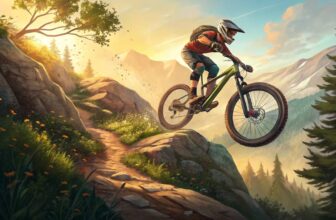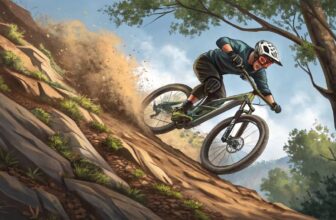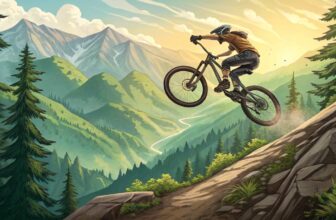Unlock the secrets to smooth and stylish mountain bike cornering with our expert guide! Whether you’re a seasoned rider or just starting out, mastering MTB cornering techniques can transform your rides from chaotic to controlled.
Imagine effortlessly navigating sharp bends, maintaining speed, and conquering challenging terrains with confidence.
Dive into our comprehensive strategies that blend skill, technique, and the right gear to elevate your biking experience. Get ready to turn heads and trails alike as you ride with precision and flair!
Mastering Mountain Bike Cornering
Importance of Eye Positioning
Nailing that perfect mountain bike corner starts with where you peek. Keeping your peepers up and eyes scanning the bend helps you spot roadblocks before they give you a surprise. Aim your noggin’ where you wanna go to help mold your body naturally.
Key Factors:
- Look Where You’re Headed: Set your sights on where the turn ends, not just what’s right under your tires.
- Take a Gander Ahead: Keep an eye out for any rubble, stones, or nasties waiting on the trail.
Mixing these steps into your ride can up your corner game. Check out more mountain biking wisdom at mountain biking basic skills.
Effective Braking Techniques
Figuring out your braking groove is critical for tackling those mountain bike corners like a pro. Nailing the brakes just right before a bend gets you through without a hiccup.
| Braking Technique | Description |
|---|---|
| Pre-Corner Braking | Hit the brakes before the corner to slow down and stay in the zone. |
| Ease Off Gradually | Steady pressure on the brakes helps dodge skids and keeping it smooth. |
| Mix Front and Rear Brakes | Use both brakes: more front brake before the turn, and rear as needed during the twist. |
Here’s how to fine-tune your braking mojo:
- Brake Early: Start slowing down before you reach the turn for a cozy ride.
- Shift Your Weight: Lean back a tad when braking to keep things stable.
- Avoid Locking Up: Gently adjust pressure to prevent wheel lock-ups that could throw you off balance.
Want more about brakes and biking dynamics? Peep into our detailed mountain bike brakes comparison.
Weaving these tricks into your ride will level up your turn-taking skills and bring more joy to your biking adventure. Don’t forget to keep your mountain bike maintenance checklist on point for every thrilling ride.
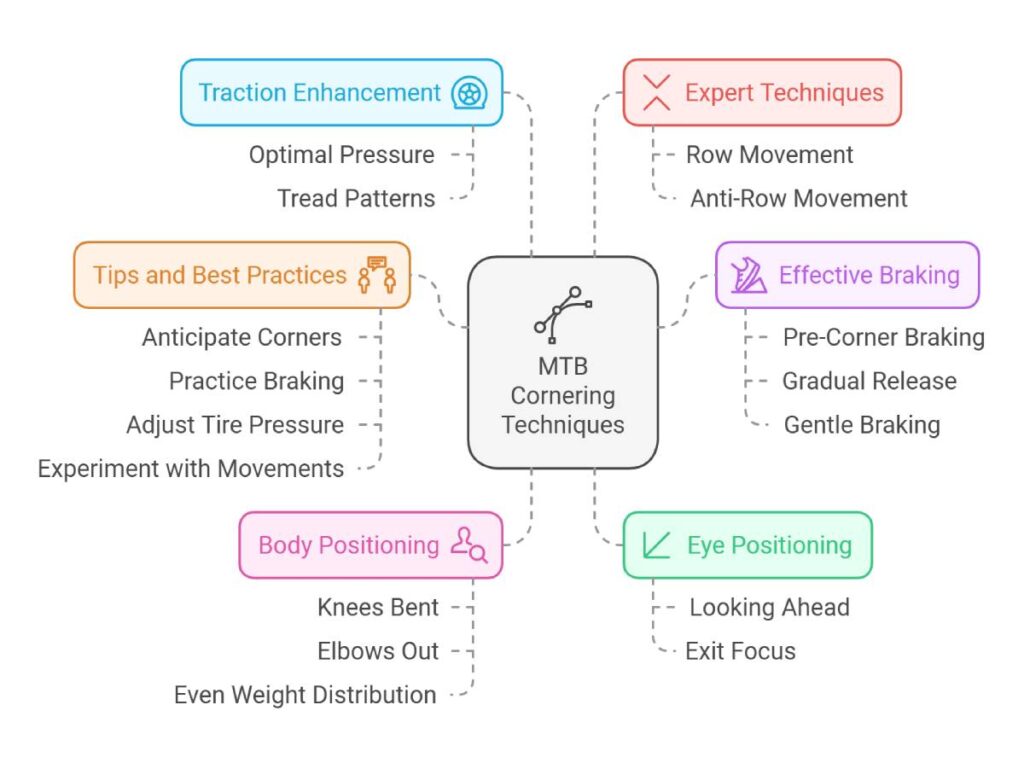
Body Position for Cornering
Getting your body in the right spot on a mountain bike can make all the difference when you’re trying to nail those tight corners. Knowing the balance between staying upright and spreading your weight can make your ride smoother, especially when the trail gets tricky.
Perpendicular Alignment’s Impact
Imagine balancing a stack of books as you turn a sharp corner. Keeping yourself as upright as a pole helps you stay on the bike and not in the dirt. This upright stance links you to the earth, boosting your grip and steering. Whether it’s dusty or muddy, you’ll find the bike doesn’t slide away.
Key Points:
- Stay Balanced: Keeping your body straight to the ground keeps your bike where you want it.
- Grippy Tires: The right stance means your tires won’t wiggle or skitter.
- Ride Like a Pro: Knowing you’re stable lets you dive into corners like a daredevil.
Weight Distribution Strategy
Knowing where to plop your weight down can mean better control and grip. Sitting low and centered on the bike keeps things balanced, helping those wheels stick to the trail when you’re cornering.
Key Points:
- Stay Low, Stay In Control: Keep your weight down and in the middle to help you zip around those tight turns.
- Hinge Those Hips and Crank That Core: A solid middle and good hip bend keep you locked onto the bike, ensuring you’re the boss on the trail.
- Feet and Knees Know Best: Put your feet just right and keep those knees back for stability where the trail gets nasty.
| Move | Why It Helps |
|---|---|
| Straight and Upright Posture | Boosts Balance & Grip |
| Crouched and Centered | Keeps Traction & Control |
| Hip Bending | Spreads Weight Right |
If you’re curious about more mountain bike smarts, check out our guides on mtb braking techniques, mtb suspension setup, and mountain biking basic skills. Nail these techniques, and you’ll corner like a champ, no matter where your bike takes you.
Optimal Body Positioning
Getting your body settled in the right spot on your mountain bike isn’t just about looking cool — it’s a game changer for tackling corners and keeping those wheels glued to the ground. Let’s dig into why keeping low and centered is your best bet and how to switch things up as the terrain throws different stuff your way.
Low and Centered Position
Being low and centered isn’t just biker lingo — it’s your ticket to sticking those corners like glue. When you’re crouched down and smack dab between your handlebars and seat, your weight’s evenly spread, giving you mad control and grip when you’re leaning into a corner. It kinda makes you feel like you and your bike are one — handling slick bends and gnarly sections without breaking a sweat.
Why Should You Care?
- More Control: Drop that center of gravity and boom, you’ve got yourself solid balance.
- Even Weight: Keep that pressure steady on your wheels for grip city.
- Fast Reflexes: Helps with those quick flicks and sudden changes.
Want the insider tricks on nailing this position? Check out our guide on mtb body position.
Adjusting Body Position for Terrain
No two trails are the same. So, knowing how to tweak your stance when the ground beneath your tires changes is key to flying around corners like a pro. Staying low and balanced works wonders on the rocky stuff, but you might want a bit of a different angle when the path is smooth sailing.
Rough or Technical Terrain:
Riding through rough terrain? Keep your body low and centered. This helps you stay in control and hold your ground over twisting roots and wild rocks.
| Terrain | How to Position Your Body |
|---|---|
| Rocky Roots and Bumps | Low and Centered |
| Uneven Paths | Low and Centered |
Smoother Terrain:
When you’re cruising on smoother paths, stand up a tad. You can afford to loosen up and use a slightly upright stance while keeping that center of gravity low for the perks of grip and balance.
| Terrain | How to Position Your Body |
|---|---|
| Even Trails | Slightly Upright |
| Flowing Singletrack | Slightly Upright |
Looking to learn more about handling your bike in different conditions? Cruise on over to our mountain biking basic skills for more guidance.
Practical Tips:
- Keep Your Eyes on the Prize: Always look where you wanna go. It helps in shifting your body beforehand for those snappy adjustments.
- Brake Smart: Get your braking done before the corner hits. This means your body stays steady and low (mtb braking techniques).
- Lean In: Tilt that bike into corners, while your body stays low and dead-center, to grip that dirt like a champ.
All in all, knowing how to move your body for different trail types is crucial for nailing mtb cornering techniques. Staying low and centered means more traction and more control, so you can dive into corners with swagger and ease.
Enhancing Traction
Keeping your mountain bike steady and controlled while turning is all about how well you can grip the trail. Mastering traction translates to mastering those hairpin corners and epic downhills.
Influence of Tire Pressure
Think of tire pressure as your bike’s secret sauce for gripping the track. Tweaking it just right can be a game-changer, especially when the ride demands technical skill and adaptability.
| Tire Pressure (PSI) | Terrain Type | Pros | Cons |
|---|---|---|---|
| 20-25 | Bumpy, Tricky | Better bite on surfaces | Might pinch the tube, slow going on the flat parts |
| 25-30 | Mixed Bag | A nice middle ground | Could hit bottom on really rough patches |
| 30-35 | Smooth Sailin’ | Quick and easy rolling | Slips more, watch out for skidding |
Too pumped up, and your tires could lose their grip on rugged sections. But let those tires get too squashy, and you’re in for some wobbly, less efficient rides with extra hazards. The sweet spot? That’s your call, depending on the terrain and style.
Find out more about getting that pressure just right in our mtb tire pressure guide.
Other Factors Affecting Traction
Tire pressure ain’t the only player in the game when it comes to keeping traction tight on your mountain bike:
- Tire Tread: Tire tread is like the unsung hero, carving up grip where it counts. Deep, gnarly patterns excel in messier conditions. Flatter treads? They’re your go-to for keeping steady on the hard, flat stuff. For more tire talk, check our guide on mtb tire compounds.
- Suspension Settings: Dialing in your suspension right can make the difference between a bumpy ride and a smooth glide. It’s all about that sweet touch between your bike and the earth. Peek at our mtb suspension setup piece for more tricks on tuning your ride.
- Body Position: Where you shift your weight as you zoom through corners changes everything. Staying low and leaning into it keeps things stable and grips those turns tight. Get more tips on body positioning with our mtb body position guide.
- Brake Positioning: Having your brakes set up well can save you from nasty skids while staying in full control of your speed. Look into our mountain bike brakes comparison for a how-to on fitting the right brakes.
- Protective Gear: Trust us, rocking some protective gear like knee and elbow pads ups your game. It lets you hit the tracks with boldness. Have a look at our picks for trail riding knee pads.
Nail these factors to ride smoother and corner with confidence. For more primo tips and tricks, pop over to our handbook on mountain biking essentials.
Expert Cornering Techniques
Row and Anti-Row Movements
Getting the lowdown on row and anti-row movements can crank up your cornering game significantly, making you the boss of those turns with smoothness and control. These moves are all about shifting your body right and managing your bike’s position like a pro on the track.
Row Movement:
- Lifts the front wheel over pesky obstacles.
- Lets you slide into turns like butter.
Anti-Row Movement:
- Pushes down the back wheel after an obstacle.
- Keeps you steady and rolling like a champ through turns.
Timing’s the name of the game here. Nail it and your bike stays glued to the trail, keeping you in control every time.
| Technique | Purpose | Outcome |
|---|---|---|
| Row | Lift front wheel | Smooth as silk turn-in |
| Anti-Row | Push rear wheel | Rock-solid momentum |
If you’re in the mood for more wisdom on keeping it together while tackling trails, check out our piece on mtb line choice.
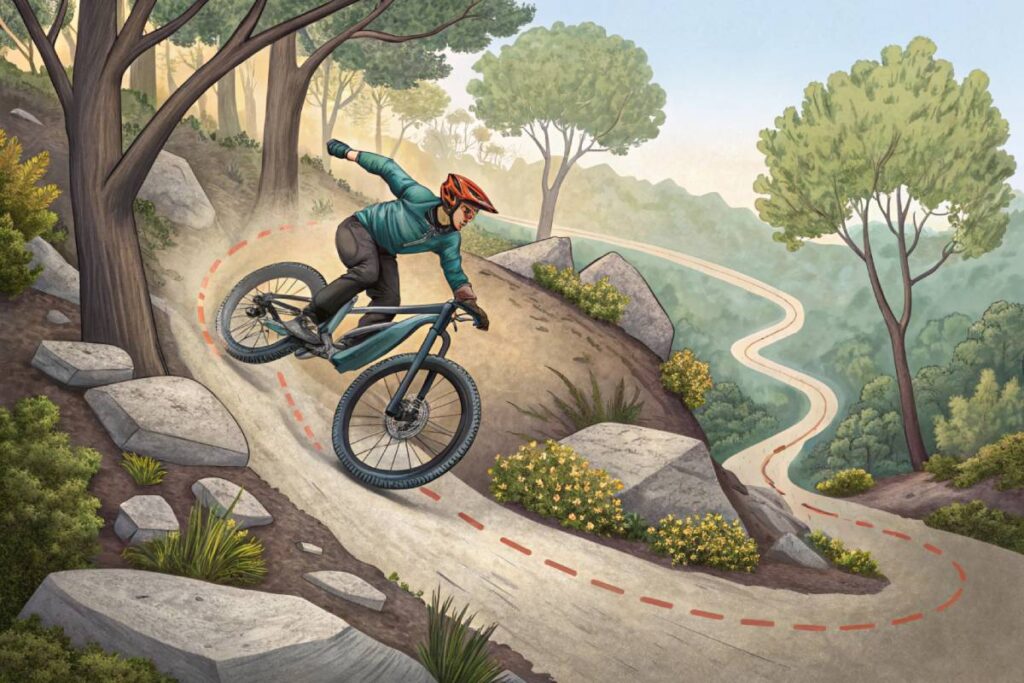
Weight Application for Improving Braking
Knowing where to plop your weight while cornering can turn braking into a smooth operation. Distributing weight right boosts traction, a must-have for nailing brakes, especially on those sandy or jagged trails. Mix row and anti-row maneuvers with smart weight shifts and get ready for some ace braking action.
Weight Forward:
- Plant your weight over the front wheel.
- Grips the front tire like a champ for precise braking.
Weight Back:
- Scooches weight towards the rear wheel.
- Stops the rear wheel from skidding and keeps things steady.
Get your weight shifts and timing just right and you’ll slice stopping distances while cruising through trails like a master.
| Weight Shift | Effect | Benefit |
|---|---|---|
| Forward | Power-ups front tire grip | A+ braking |
| Back | Stops those slips | Keeps it steady |
This dance of weight and brakes is the secret to slaying technical trails. For deeper dives, hit up our guide on mtb braking techniques.
By getting these rad cornering techniques down, mountain bikers can level up their skills for safe and epic rides. If these notions are new to you, investing in practice and tutorials—like learning how to manual a mountain bike—can be a game changer.
Achieving Speed Through Turns
Maximize Momentum in Corners
Here’s the deal with cornering on a mountain bike: it’s all about efficiency. If you’re trying to up your speed game through turns, check out these handy tips:
Entering the Turn Wide
Swinging into a turn from as wide as you can get gives you a smooth, flowing path instead of a jittery, tight turn, letting you keep both your speed and balance in check.
High Line in Berms
When it comes to bermed corners, taking the high road (literally) can keep you moving fast. Staying high on the berm lets gravity do some of the work, so you avoid the tighter, slower bits of the turn.
Timing the Row and Anti-Row Movements
These moves are super important in cornering. Trainer Road explains how they work:
- Row Movement: As you roll into a turn, push the bike out in front and reach with your arms. It shifts the weight back, keeping you stable.
- Anti-Row Movement: When you’re coming out, pull the bike back towards you and grip tight. This moves your weight forward, helping you pick up speed as you leave the corner.
Utilizing Movement Patterns
How you position yourself and move can really crank up your cornering skills and pace:
Neutral and Ready Positions
REI suggests the right body position is a game-changer:
- Neutral Position: Great for those easy sections. Stay loose, with a slight bend inyour arms and knees, and share your weight evenly.
- Ready Position: For those gnarly bits. Drop your center by bending your knees and elbows more, and lean your weight a little back.
Adjusting Seat Position
Getting the seat right can make a big difference in climbs and drops. For going uphill, keep your seat high to get the best pedal push, with a slight leg bend when almost fully extended. On the flip side, drop that seat when going downhill to keep control by lowering your center of gravity.
Table: Movement Patterns and Speed Optimization
| Technique | Description | Benefit |
|---|---|---|
| Enter Wide | Starting the turn from the farthest point | Keeps speed up |
| High Line in Berms | Sticking to the high part of berms | Maintains momentum and control |
| Row Movement | Extending arms and pushing bike into the turn | Stabilizes bike entry |
| Anti-Row Movement | Pulling bike towards you when leaving turn | Kicks up speed on exit |
To level up your riding chops, poke around at more mountain biking basic skills and mtb body positioning guides. These tricks can seriously amp up your speed and control in turns, leading to one wild and confident ride.
Mastering Different Turns on Your MTB
Do you know how to handle those tricky turns on your mountain bike? Yep, it’s a must for all riders. Let’s break down some techniques for the curvy switchbacks and those often bermed turns.
Tackling Switchbacks
Switchbacks, those tight zig-zags on steep slopes. They demand a bit of know-how to tackle whether you’re facing an uphill climb or a speedy downhill. The essentials: lean forward, elbows wide, knees bent, and weight spread on both tires.
Your pedals should sit evenly with equal weight distribution. Yup, eyes up and a light grip on the brakes for sure! For a deeper delve, check out the mtb switchback technique for some killer advice.
Climbing Switchbacks
How to make that uphill climb a bit less taxing:
- Keep your pedals moving smoothly and constantly.
- Lean forward a bit so your front wheel sticks to the ground.
- Pick a lower gear, it’s your best buddy for a steady pace.
- Eye on the prize: the path. Aim your inside knee at the turn and tilt that bike while you keep your torso tall.
Descending Switchbacks
Headed downhill? Here’s what you need:
- Keep tabs on speed with both brakes – no fancy tricks here.
- Lean back to stay right in control.
- Nudge that bike into the turn, but you? Stay center.
- In a higher gear, the ride’s much smoother through the turn.
Techniques for Bermed Turns
Berms are like those rounded edges on trails, there to help you sail through tight turns. Check out if the dirt up there is holding strong. Here’s the game plan for approaching a berm:
- Moderate speed’s key to keeping a grip and not losing it all.
- A slight lean back and keeping low helps steer better.
- Bank into the berm with the bike straight up to the ground.
- Brakes – a light touch on the back to prevent skids.
- As you exit, straighten and pedal to keep moving.
Here’s a cheat sheet for those turns:
| Technique | Weight Shift | Must-Dos |
|---|---|---|
| Uphill Switchbacks | Forward | Steady pedals, low gear, lean bike right |
| Downhill Switchbacks | Back | Smooth braking, turn lean, high gear glide |
| Bermed Turns | Back | Control speed, lean hard, slide out with style |
Hoping these tips hit home! Want more BMX wisdom? Hit up our mountain biking basic skills for even more insights.
Get playful with those curves, but remember: from bike setup checks at mtb suspension setup to tightening those nuts (figuratively and literally) over at mountain bike maintenance, having a grip on your gear doubles the fun on the trails.
Handling Off-Camber Corners
Off-camber corners in mountain biking throw a curveball at riders, with the trail sloping downwards on the outside. Gravity’s not your friend here, and mastering these bends takes finesse and the right tricks up your sleeve. Let’s break down how to ride these tricky turns without ending up in the bushes.
Challenging Terrain Approaches
Handling these slanted curves starts with making sure your bike sticks to the ground like peanut butter on toast. Here’s how you can tackle this:
- Drop That Tire Pressure: Think of tire pressure like Goldilocks — not too hard, not too soft, just right. Let out some air so your tires hug the ground, giving you the grip you need to hug those corners tightly. A hard tire will bounce you around like a pogo stick, while a flat one will leave you floundering. Want more tips? Check out our deep dive on mtb tire pressure.
- Tweak Your Gear: It’s like dressing up your bike for a party. Adjusting tire pressure, brake setup, and suspension lets your ride dance with the trail instead of fighting it. And don a helmet, knee, and elbow pads; trust us, they’re a lot comfier these days and might save you a scrape or two. Our articles on mtb suspension setup and mtb braking techniques go into the nitty-gritty details.
- Nail the Body Stance: Picture you’re in a squat — knees bent, elbows out, body low. This position keeps you glued to your bike and lets you soak up the trail.
Focus on Grip and Stability
Gliding through these corners without a hitch means mastering grip and balance. Here’s the scoop:
- Shift Your Weight: Put some heft on the outside pedal while staying balanced. It’s like leaning into a dance partner — it keeps you on your feet. Weighting that pedal up enhances grip and prevents your bike from skidding out.
- Brake Like a Pro: Squeeze those brakes thoughtfully as you approach the turn and lay off during the turn. Slam them mid-turn, and you’re asking for a wipeout.
- Pick Your Path: Like choosing the longest queue at a coffee shop (just kidding, the shortest), there’s a right line through every corner. Hug that inside line and leave the loose stuff on the outer edge for others.
| Key Tips | What to Do |
|---|---|
| Tire Pressure | Go a bit softer for a stickier ride |
| Body Stance | Stay low and feel the bike |
| Braking | Feather those brakes early |
| Weight | Ride the outside pedal hard |
Blending these skills with the right gear gets you smoothly through the corner, leaving other riders eating your dust. Still looking for more off-road biking wisdom? Dive into our write-ups on riding rock gardens mtb and mtb line choice. And for safety stuff, check our guide on trail riding knee pads.
Now go conquer those pesky corners and show that trail who’s boss!
Conclusion
Mastering mountain bike cornering is more than just technique—it’s about the seamless blend of skill, body control, and the right equipment. By focusing on where you look, how you break, and your body positioning, you can navigate even the most challenging trails with ease and confidence.
Adjusting tire pressure and suspension settings further enhances your traction, ensuring you stay glued to the trail through every twist and turn. Implementing advanced movements like row and anti-row can elevate your control and smoothness, making every ride a thrill rather than a struggle.
Whether tackling switchbacks, bermed turns, or off-camber corners, these strategies equip you to handle any situation with finesse. Remember, consistent practice and fine-tuning your gear are key to becoming a cornering champion.
Embrace these techniques, stay safe with the right protective gear, and enjoy the exhilarating freedom that comes with mastering MTB cornering. Your ultimate biking adventure awaits—ride smart, ride strong!
FAQs
What is the most important aspect of MTB cornering?
The most important aspect is eye positioning—always look where you want to go to naturally guide your body through the turn.
How should I adjust my brakes before a corner?
Brake early by applying both front and rear brakes before entering the corner to reduce speed and maintain control.
What body position should I maintain while cornering?
Stay low and centered with knees bent and weight distributed evenly to enhance stability and grip.
How does tire pressure affect cornering?
Proper tire pressure ensures optimal grip; lower pressures for rough terrain and higher pressures for smooth trails.
What are row and anti-row movements?
Row movements involve lifting the front wheel over obstacles, while anti-row pushes the rear wheel down to maintain stability during turns.
Final Thoughts
Mastering MTB cornering is a journey that combines technique, practice, and the right equipment. By honing your eye positioning, braking, and body stance, you can navigate any trail with confidence and grace.
Remember, each trail presents its own challenges, so adaptability is key. Continuously fine-tune your skills and gear settings to match the terrain, whether you’re facing rugged switchbacks or smooth bermed turns.
Protective gear not only ensures safety but also enhances your performance by allowing you to push your limits without fear. Engage with the mountain biking community, seek out tutorials, and never stop learning to keep elevating your riding experience.
Embrace the thrill of mastering each corner, and let your passion for mountain biking drive you to new heights of adventure and achievement. Here’s to countless epic rides ahead—ride safe, ride smart, and enjoy every twist and turn!
Key Tips
- Look Ahead: Always focus on where you want to go, not just at your front wheel.
- Brake Early: Apply both brakes before entering a turn to reduce speed and maintain control.
- Stay Low and Centered: Bend your knees and keep your weight balanced for better stability.
- Adjust Tire Pressure: Lower for rough trails, higher for smooth paths to optimize grip.
- Practice Row and Anti-Row: Enhance control and smoothness during turns with these movements.
- Shift Your Weight: Distribute your weight appropriately to maintain traction and prevent skids.
- Wear Protective Gear: Ensure safety while pushing your limits on the trails.
Recommended Biking Products and Accessories
- Mountain Bike Tires: Maxxis Aggressor – Versatile traction for various terrains.
- Brake Pads: Shimano Deore Brake Pads – Reliable stopping power.
- Suspension Fork: RockShox Pike – Adjustable damping and travel for smooth rides.
- Protective Gear: Fox Racing Ranger Knee and Elbow Pads – Safety without sacrificing mobility.
- Handlebars: Renthal Fatbar Pro – Enhanced control and comfort.
- Hydration Pack: CamelBak M.U.L.E. – Stay hydrated on long rides.
- Cycling Gloves: Giro DND Gloves – Improved grip and hand protection.
- Bike Pump: Topeak Joe Blow Sport III – Quick tire pressure adjustments on the go.
- Multi-Tool Kit: Park Tool MTB-TOOLS – Essential for on-trail bike maintenance.
- Action Camera: GoPro HERO10 – Capture your epic rides with high-quality video.
By implementing these strategies and utilizing the recommended resources, you’ll elevate your mountain biking cornering skills to new heights. Happy riding!

